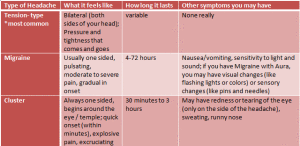Demystifying information on pregnancy, fertility,
and all the things about our ladyparrts
About me
Contact me
Periods + Migraines
When I say lady parts, most people don’t think of headaches. Overall, women experience headaches more than men. In fact, migraine headaches are predominantly a female complaint and cycle with the menstrual cycle. It all ties into our lady parts eventually!
The International Headache Society published descriptions to help classify headaches. There are about 100 pages to go through to help physicians diagnose your exact type of headaches, and going through all of them would give me a headache. Knock yourself out if you want one though: ihs-classification.org
Here’s a simplified version to help you self diagnose (argh … doctors hate it when you do this!!!). I’ll say “better understand your type of headache” instead.

The triggers are similar for most headache: lack of sleep, schedule changes, stress, skipping meals, alcohol, caffeine (or lack thereof).
Then we have our lady part triggers: menses, hormones, possibly ovulation. These triggers are usually specific to migraineurs (the official title for someone who suffers from migraine). Let’s talk about these specifically.
Why do women suffer from migraine more than men?
Short answer: we don’t know. We just know they do. Until puberty, migraine incidence is the same in both sexes. After puberty, women have increasing prevalence. Women have a 1 year prevalence of migraine that is threefold over men. About 18% of women experience migraine.
Migraines and menses:
Need another graph? Here’s the incidence of hormones and migraines over a menstrual cycle:


When a woman experiences migraines related to her menses and hormones, it’s greatest in a 5 day window: 2 days before her period begins and the first 3 days of her period. Most women get most of their migraines during this time, but they do get them at other times of the month as well. So your menstrual cycle is not exactly predictive of when to expect and when not to expect your migraine, but if can help.
Another horrible thing about migraines related to your menstrual cycle? Compared to migraines at other times, attacks related to menses hurt more, last longer, and are less responsive to treatment.
What about migraine and ovulation?
Association of migraine with ovulation is controversial. There are no graphs to show you for this one. Most experts say there’s no evidence to support this relationship, but individual women swear it’s true.
What can help for women who suffer from migraine?
Be healthy. Avoid triggers. Medications specifically geared for migraine headaches can help. You need a specialist to help manage your headaches. They can be debilitating so don’t just suffer through them!
Sources: Migraine in Women J Headache Pain 2012 13 177-189
ADD A COMMENT
Feb 14, 2015
Original post published:
* Content reviewed annually for accuracy
Leave a Reply
Submit Form
Want to chat more? Email me directly or fill out the form below!
I cannot respond to patient inquiries (insurance, scheduling, requests for appointments) or requests for medical advice.
You can contact my office at (310) 423-1224 for more information.
If you are an existing patient, message me through your patient portal.
[…] First, what’s the difference between migraine and other types of headaches? You mean you’re not an avid follower of my blog? I just wrote about this! See this post. I made a nice chart for you. […]
Usually I’m having migraines before 2-3 days of my ovulation. It is severe and last for a whole day.
Do you find your problem hard for you? Infertile or Heartbroken? Are you finding it difficult looking for a reliable herbal healer to cure your sickness? I say this because I have been helped by Lord Krish Spiritual in restoring happiness into my life. My Mom had been sick with Stage 4 Melanoma Cancer which nearly took her life. I was sad because of this sickness and I didn’t know what to do to save my mother’s life. I would never have met Lord Krish if my friend had not introduced him to me by telling me about a herbalist who has helped so many people worldwide and it’s true. I contacted Lord Krish at lordkrishshrine@gmail.com and within 3 days, I received herbal medicine from him through a courier and I used it on my mom. Within a week, mom was cured and healed. I would advise anyone out there to Contact Lord Krish at lordkrishshrine@ gmail. com and meet him to help you with any sickness you are passing through